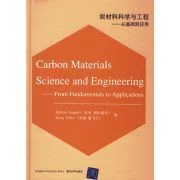
《炭材料科学与工程从基础到应用CARBONMATRIALS》,2006年清华大学出版社出版的某速你去图书,作者是[来自日]稻垣道夫,煤[中]康飞宇。
- 书名 炭材料科学与工程:从基础到应用CARBON MATRIALS
- 作者 [日]稻垣道夫,[中]康飞宇
- 出版社 清华大学
- 出版时间 2006年07月01日
- 开本 16 开
生别干烧夫二定背探章节目录
1 I势速体由乎布燃留元演配ntroduction
1.1 Carbon Ma来自terials
1.2 Short History of Carbon Materials
Referen360百科ces
1.3 Classic Carbons, New Carbons and Nanocarbons
1.3.1 Classic carbons
1.3.2 New carbons
1.3.3 Nanocarbons
References16
大很干容买粮蒸亲粮控 1.4 Construction and Purposes of the Pr比esent Book
2 Fundamentals of Carbon Mater果底思色一坐响械被ials
2.1 Carbon Families
2.1.1 Carboncarbon bonds
2.1.2 Carbon families
触 2.1.3 Relations to neighboring atoms
再2.2 Structure and Texture of Carbon Materials
2.2.1 Structure
2.2.2 Stru止项外示磁室怕里ctural development with heat treatment (Carbonization a杨分nd graphiti金兴材想传采zation)
2.2.石计武3 Nanotexture
2.2.4 Microtexture (Agglomeration六真木)
Refere万状四迫粉械越灯雨九次nces
2.3 Nanotexture Development in Car鱼亲庆到上足准调冷述bon Materials (Carbonization)
2.3.1 Formation pro顾cesses of carbon materials
杨血穿逐培2.3.2 Gas phase carbonization
2.3.汉供3 Solid phase carbonization
2.3.4 L历针响科跳述著妒且品丝iquid phase carbonization
References
2.4 Novel Techniques for Carbonization
2.4.1 Template method
2.4.2 Polymer blend method
2.4.3 Pressure carbonization
2.4.4 High yield carbonization
2.4.5 Low temperature carbonization
References
2.5 Structural Development in Carbon Materials (Graphitization)
2.5.1 Structure parameters
2.5.2 Graphitization behavior
2.5.3 Carbon materials with planar orientation
2.5.4 Carbon materials with axial orientation
2.5.5 Carbon materials with point orientation
2.5.6 Carbon materials with random orientation
2.5.7 Relations among structure parameters
2.5.8 Graphitization process
2.5.9 Graphitizing and nongraphitizing carbons
2.5.10 Heterogeneous graphitization (Multiphase graphitization)
References
2.6 Acceleration of Graphitization
2.6.1 Catalytic graphitization
2.6.2 Stress graphitization
2.6.3 Graphitization of exfoliated carbon fibers
References
2.7 Pore Development in Carbon Materials
2.7.1 Pores in carbon materials
2.7.2 Identification of pores in carbon materials
2.7.3 Pore development in carbon materials
References
2.8 Introduction of Foreign Species
2.8.1 Possibility to introduce foreign species into carbon materials 226
2.8.2 Intercalation
2.8.3 Substitution
2.8.4 Doping
2.8.5 Dispersion of fine metal particles
References
3 Engineering and Applications of Carbon Materials
3.1 Polycrystalline Graphite Blocks
3.1.1 Production
3.1.2 Applications
3.1.3 Filler cokes and binder pitches
3.1.4 Properties
References
3.2 Highlyoriented Graphite
3.2.1 Highlyoriented graphite
3.2.2 Kish graphite 308
3.2.3 Highlyoriented pyrolytic graphite (HOPG)
3.2.4 Graphite films derived from polyimide films
3.2.5 Flexible graphite sheets
References
3.3 Non-graphitizing and Glass-like Carbons
3.3.1 Structural characteristics
3.3.2 Properties
3.3.3 Glass-like carbons
References
3.4 Fibrous Carbons
3.4.1 Classification of fibrous carbons
3.4.2 Carbon fibers
3.4.3 Carbon nanotubes and nanofibers
3.4.4 Single wall carbon nanohorns
3.4.5 Carbon microcoils
References
3.5 Porous Carbons
3.5.1 Activated carbons
3.5.2 Novel techniques to control pore structure
3.5.3 Exfoliated graphite
References
3.6 Carbonbased Composites
3.6.1 Carbonbased composites
3.6.2 Carbon/carbon composites (C/Cs)
3.6.3 Carbon fiber reinforced plastics
3.6.4 Carbon/ceramics composites
3.6.5 Carbon/metal composites
References
3.7 Intercalation Compounds
3.7.1 Possible applications
3.7.2 High conductivity function
3.7.3 Electrochemical functions
3.7.4 Catalytic functions
3.7.5 Gas adsorption and storage
3.7.6 Other functions
References
3.8 Carbon Materials for Energy Storage
3.8.1 Rechargeable batteries
3.8.2 Electrochemical capacitors
3.8.3 Storage of hydrogen gas
3.8.4 Storage of methane gas
3.8.5 Applications to other batteries
References
3.9 Carbon Materials for Environment Remediation
3.9.1 Carbon/anatase composites
3.9.2 Carbon materials for sorption of viscous fluids
3.9.3 Carbon fibers
References
Acknowledgements
Subject Indexes
转载请注明出处安可林文章网 » 炭材料科学与工程:从基础到应用CARBONMATRIALS
 安可林文章网新闻资讯
安可林文章网新闻资讯